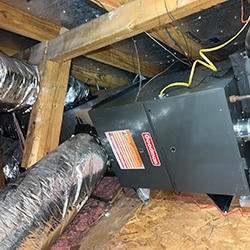How To Check Your Ductwork
Your home’s ductwork plays a crucial role in delivering warm or cool air throughout your home
How To Check Your Ductwork
If you suspect something might be wrong, you can perform a quick air duct inspection yourself. Here’s a homeowner-friendly guide from Air Dynasty on how to check your ductwork and spot common problems before they turn into expensive repairs.
1. Turn Off Your HVAC System
Before inspecting your ducts, always turn off your HVAC system. This ensures your safety and prevents the fan from circulating dust or debris while you work. Allow the system to sit idle for at least a few minutes so air pressure inside the ducts stabilizes.
2. Inspect Visible Ducts for Damage
Start with the sections you can see—usually in the attic, basement, or crawl space. Look for any obvious signs of wear, such as:
Holes or cracks in metal ducts
Loose or disconnected joints
Sagging flexible duct lines
Rust, corrosion, or water stains
Areas where duct tape has peeled or aged
These visible issues can cause conditioned air to leak, forcing your system to work harder and reducing efficiency.
3. Feel for Air Leaks
Turn your HVAC system back on and let it run for a few minutes. Then, carefully run your hand along the seams and joints of your ductwork. If you feel air escaping, that’s a sign of a leak.
For a more precise check, you can hold a small strip of tissue or lightweight paper near the ducts—if it flutters, you’ve found a leak. Even small leaks can lead to significant energy loss over time.
4. Listen for Unusual Sounds
While your system is running, listen closely for whistling, rattling, or vibrating noises coming from the ducts. These sounds may indicate gaps, loose connections, or pressure imbalances.
Rattling often means a duct section has come loose, while whistling could point to escaping air through a crack or hole.
5. Check for Dust and Debris Around Vents
Excess dust around vents or registers can signal that your ducts are dirty or leaking. When leaks occur, your HVAC system can pull in dust from attics, basements, or crawl spaces and distribute it throughout your home.
If you notice a buildup of dust or an increase in allergy symptoms, it may be time to have your ducts professionally cleaned or sealed.
6. Monitor Airflow in Each Room
Walk through your home and check the airflow from each vent. Weak airflow in certain rooms can indicate blockages or leaks in your ductwork. Uneven heating or cooling is another common sign that your ducts aren’t distributing air properly.
7. Look for Signs of Mold or Moisture
Moisture buildup near ducts is a serious issue. Mold thrives in damp environments and can spread quickly through your home’s air system. If you see dark spots, smell musty odors, or notice condensation on ducts, call a professional immediately. Mold-contaminated ductwork needs expert cleaning and possibly replacement.
When to Call the Professionals
While these steps can help you spot problems early, a thorough duct inspection requires specialized tools and knowledge. The experts at Air Dynasty use advanced equipment to detect hidden leaks, measure airflow, and check insulation levels to ensure your entire HVAC system is performing efficiently.
Professional duct inspections can uncover issues that aren’t visible to the naked eye—helping you improve comfort, lower your energy bills, and extend the life of your HVAC system.

How To Check Your Ductwork
Keep Your Air Flowing Smoothly with Air Dynasty
Your ductwork is the hidden backbone of your home’s comfort. A quick check every few months can help catch issues early, but for a complete evaluation, trust the professionals at Air Dynasty.
Whether you need duct repair, cleaning, or a full HVAC inspection, our team is ready to help you breathe easier and save energy all year long.
Contact Air Dynasty today to schedule your duct inspection and make sure your home’s air system is running at its best.

